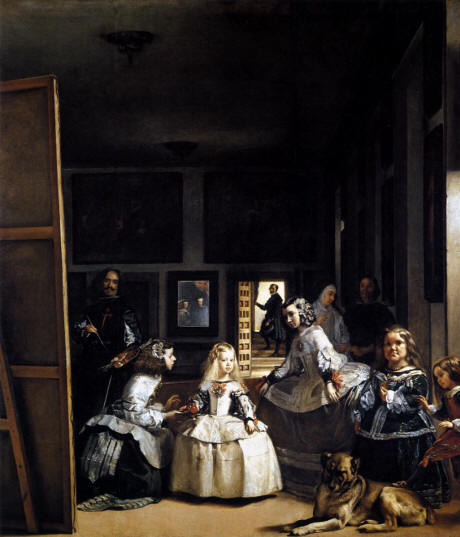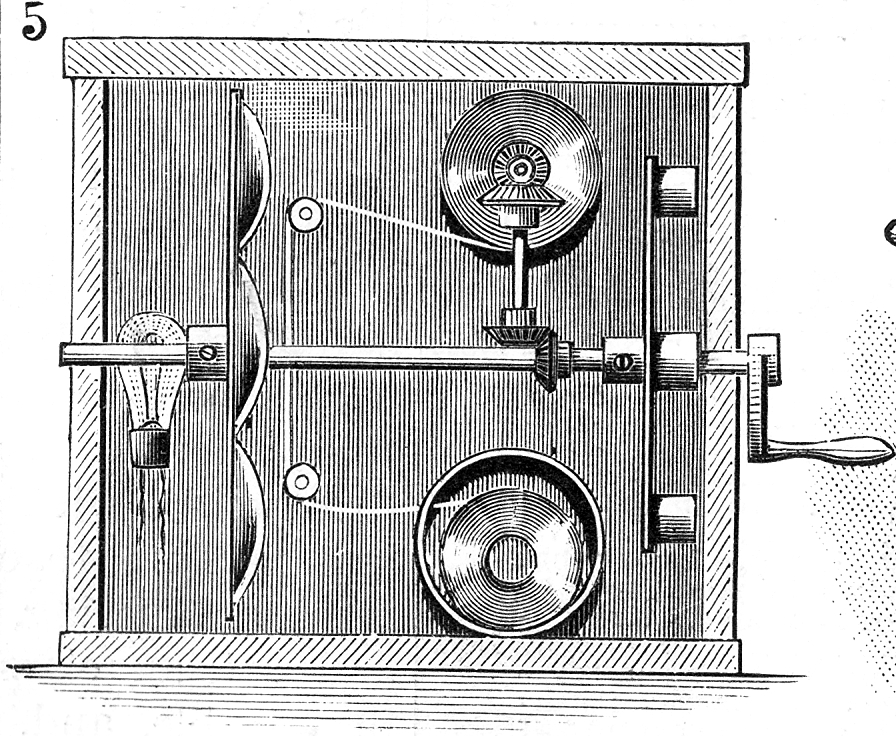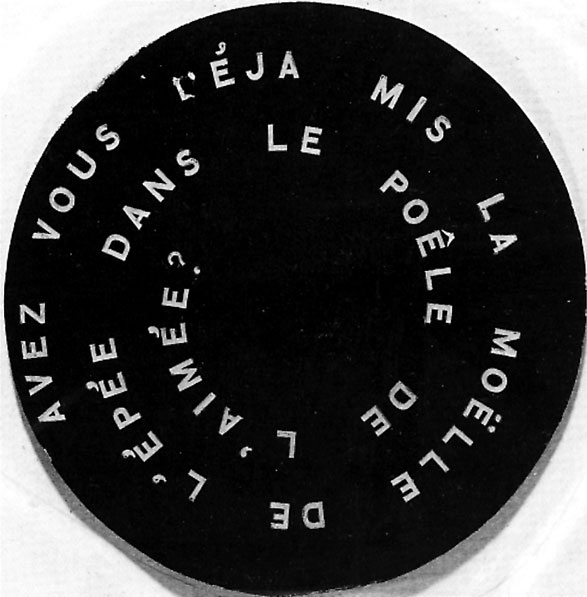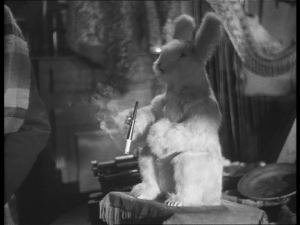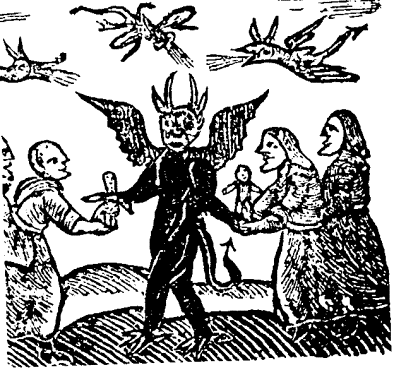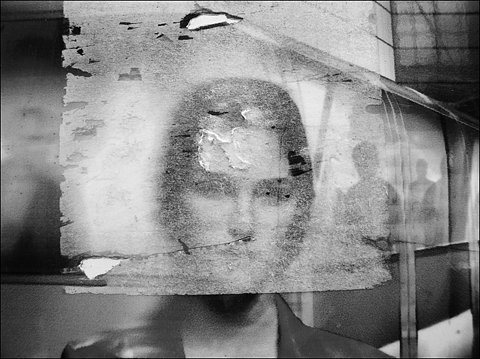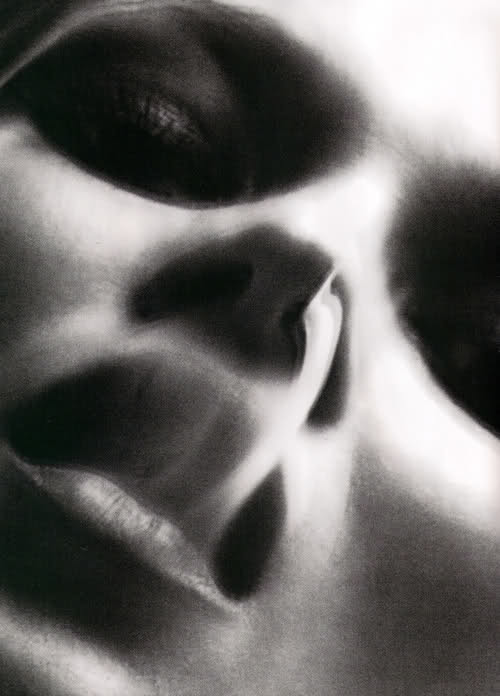Originally published in: Parallelogramme Vol. 8, No. 2 December 1982-January 1983
This film, I.E., was made by Ross McLaren in 1976, just at the end of the so-called “structural” film movement in North America. The film is composed of a series of themes and variations involving the interaction of camera and filmmaker. There is a predominance of in-camera animation, and the resultant distortions and manipulations both reveal and conceal the process of the film’s making. I.E. is about illusion, though there is no doubt that the person in the film is the filmmaker, and that what he is doing is making a film.
When we go to the movies, the illusion, if you will, is that there is no illusion. The term “transparency” can be used to describe this phenomenon. We are not conscious of our complicity and reading of the complex codes and conventions that go into creating this illusion – and so it doesn’t appear to be one, or at least we can easily suspend our disbelief and “go along with” the appearances of the movie, placing the characters and plot into “reality” in obedience to the codes. Because what happens in I.E. is unexpected and not aligned with everyday perceptions, we have to wait and watch. What we see are the traces of the making of the film in so far as the procedures used are capable of transmitting them. The film causes an awareness of the illusion of movement; an illusion related to a set of specific neutral responses known as the “phi phenomenon” which is responsible not only for our perception of movement in film, but also for our perception of certain “slight of hand” magic tricks.
One is tempted to see McLaren’s film as autobiographical – there are certainly “scenes from life” in it – but on closer examination we discover that, similar to Joyce’s Ulysses, the more it reveals, the more it becomes the process itself. The human figure depicted becomes devoid of abstract value and is the vehicle for the flow of images. If we were to look at the film frame by frame we could surely get a different look at the process by examining the individual moments that go to construct the whole, yet even this examination would not reveal to us more than traces, and besides, we would then not be seeing the film – the work that it does and that we do – as we view it in its life as a film on the screen.
Michel Foucault, having analyzed in detail Las Meninas, a painting by Velasquez, says “representation undertakes to represent itself here in all its elements, with its images, the eyes to which it is offered, the faces it makes visible, the gestures that call it into being. But there in the midst of this dispersion which it is simultaneously grouping together and spreading out before us, indicated compellingly from every side is an essential void: the necessary disappearance of that which is its foundation – the person it resembles and the person in whose eyes it is only a resemblance. This very subject – which is the same – has been elided. And representation, freed finally from the relation that was impeding it, can offer itself as representation in its pure form.”[1] This description, I feel, could be applied equally to I.E. It is a description that arises out of notions of representations from the Classical Age – from the end of the Renaissance to the beginning of the nineteenth century, wherein “Representations do not derive their meaning from the world; language and meaning are inherent within them. Language is thought. As a result, its very existence ceases to be a problem.”[2]
According to Foucault, the “Classical” way of seeing things dissolved finally at the beginning of the nineteenth century, and the world began to be perceived in terms of organic structures classified by their functions, rather than isolated elements divided into same and different.[3] A sense of History and causality came to exist and at its core was, not representation, but Man. Kant, for example, showed that knowledge could reside in such unrepresentables as “Life, the Will, and the Word.” [4] Developments in natural history and language began to result in something that had not existed before: a science of man, whose proposition was that man was knowable.
The nineteenth century was the period of the cinema’s gestation. Noel Burch, a contemporary film critic, has noted that photography in the early 1800’s took over the task of describing “ownable” portions of the world – a job previously performed by painting. Photography was a necessary tool of scientific research, and through no coincidence, a tool for glorifying the individual and his conquest of nature as well. In the prolonged effort to provide a “perfect illusion of the perceptual world” various devices were developed throughout the period, culminating with the Kinetoscope, patented by Thomas Edison in 1891.[5]
Painting, meanwhile, began to take off on quite a different track. One may postulate that the advent of photography implied for the painter a tautology in the type of perspective and representation that had been established in the Renaissance. This type of pictorial representation may have seemed suddenly drained of its possibility to reveal anything more than an endless reiteration of its own self-evidence. The subsequent development of painting, as we know, saw an ever-increasing focus on the so-called “picture plane.” The “view through the window” slowly became the “view on the window,” and then the “view of the window.” Its phenomenological dissection of “reality” seemed to point more and more toward representation, particularly photographic representation, as the last thing that anyone could, or should trust. While art movements emerged from time to time which allowed a realistic representation of things, they did so with great irony. Surrealism, Dada and Pop Art point specifically to the tautology of pictorial representation, reducing it back to the common ground of the human mind.
Film and photography, therefore, from the beginning had helped to release painting from its slavishness to a certain kind of representation. But, partly because of its indexical contact with perceived reality (which in itself grew out of bourgeois, neo-classical representation which painting had been formulating for centuries) and partly because of its cost and inaccessibility, film remained a minor art, in terms of the avant-garde.
In terms of capitalism and bourgeois entertainment, it was quite another story. Since the first experiments with recording movement, by Muybridge and Lumiére had been seen as ugly or problematic by the public, the pioneers of cinema were devoted to restoring the beauty of the bourgeois theatre and novel to photography. The content of primitive cinema as a popular form was, to quote Burch again, “not really cinematography at all but magic theatre, vaudeville, salon painting, the picture postcard.”[6] Trick photography was used by Mélies and others to create magical tableaux in their films. Although, and perhaps because these tricks “couldn’t help but point up the specificity of film,” [7] i.e. illusion, disorientation, and so on, the trick film had a limited lifespan. The public’s desire to witness fantastical displays of camera-made magic was finally outstripped by their relative sophistication and by the cinema’s inability to come up with more “real” demonstrations. Cinema shifted to an arena where the suspension of disbelief was already well established, that is to the narrative drama.
In a book entitled Ur-Drama, the Origins of Theatre[8] Ernest Theodore Kirby puts forward the theory that ancient shamanic rites which were intended to convey to the audience the presence of a supernatural being were the prototypic theatrical performances. These rituals are to be found cross-culturally and are designed to affect, within a given culture, the correction of any deviation in an individual by reinforcing and intensifying belief in that culture’s world view – both in the individual him/herself, and through the audience. The technique was a combination of illusion and expectation. Numerous shamanic “miracles” are listed and accounted for in terms of their striking resemblances to contemporary sleight of hand magic tricks. The abstraction and stylization of various entities and characters, using masks, costumes and other devices within the display, did not distract from the belief, but in fact heightened the drama by placing it in a new context. Kirby likens the theatrical performance to the oneiric and trance states, wherein the disjunction from everyday reality lends credibility to the effect. The hypothesis is that the religious content of various rituals was lost, but the dramas continued and evolved. The road from shamanic ritual to theatre as we know it, is a long one. What beliefs may or may not have been embodied in theatrical performances at various times is difficult to know. There is one further point, however, that seems particularly pertinent and that is the necessarily public aspect. While ceremonial magic or rites of passage may be conducted in private, these rituals needed the endorsement of the public to fulfill their function, and consequently had to present a world-view already held by that audience.
The fact that film, then, became the vehicle for presenting and representing a widely held world-view is not surprising. The “magic” of film was not the other-worldly magic of witchcraft, but the magical power of science, progress, history, and so on. If drama had indeed acted since earliest times to help humans revive their faith as a means of overcoming problems, then the theatrical narrative with its neat closure was ready and waiting for film.
There has been a film practice since the beginnings of film, the so-called “avant-garde” practice, that had motives and aesthetic senses identical or very similar to contemporary painting or sculpture, but which actively questioned the propositional fix of cinema into narrative, exposition or poetics.[9] It may be useful to look at some examples of avant-garde cinema. In Anemic Cinema by Marcel Duchamp (1926), the filmmaker has challenged and illuminated the optical illusion of film by presenting another optical illusion through the medium. The image of rotating disks inscribed variously with spirals or with non-concentric circles which appear to form spirals during rotation, made up of sentences (puns), fool us and fool us twice. Further, as each word moves into the spot where it can most conveniently be read, the viewer anticipates and participates. Each pun has a sexual theme and the rotating “spirals” seem to move in and out from the surface of the screen in a sexually suggestive movement. This is the erotic (but anemic) aspect of cinema that feminist critics have recently begun to examine. To leave that aside for the moment, as another example, the films of Stan Brakhage deliberately do violence to Renaissance perspective and a linear time construction, but still maintain a connection with photographic representation. There is an acceptance and a rejection of representation which occur simultaneously. Over the years some filmmakers have adopted a stance which did not differ much from that used by Hollywood, but the continuity, the narrative, the unfolding of the “story” was absent or restructured. Some sought to reveal aspects of film’s nature by confining its content, taking away representation or limiting it to show the work’s shape or duration. If the narrative cinema is “magic” in the public sense of the shamanic rituals, then you could equate the “avant-garde” film with the hidden magic of witchcraft. The meaning of the witch’s magic has varied in different societies because of differing views of what magic in general actually is. But in every case, the witch is a practitioner of other than the socially accepted, official magic, and in most cases is female. Throughout Judaeo-Christianity, dualistic theologies have required a personification of evil to oppose the goodness of God. The necessity to project the “dark” side of nature onto particular individuals is found in other societies as well, and the behavior of these “witches” is frequently described as encompassing unnatural acts, such as cannibalism, incest, and flying. (it is interesting to note that these same acts are embraced by certain Tibetan mystics as necessary (if only perhaps symbolically) to spiritual enlightenment.) Reports of these kinds of occurrences may be more than the paranoia of the judges of the Inquisition and may in fact point to a real religious and mystical basis to witchcraft. There seems to be a universal correspondence, at any rate, between what is commonly thought of as a witch, and the Jungian archetype of the “shadow.” For women, the witch as the shadow is significant in that it indicates an entity in exile. In his essay The Apparatus[10], Jean Louis Baudry, in seeking an ideological basis for cinema in dreams, quotes Freud’s Interpretation of Dreams: “If the unconscious, in so far as it belongs to waking thought, needs to be represented in dreams, it is represented in them in underground places. Outside of analytic treatment, these representations would have symbolized the woman’s body or womb.” This remarkable passage puts women, the unconscious and underground all in one place. For those of us who are women, this is an acknowledgment of our exile. And the witch is the archetype of the feminine in exile. Although experimental film is neither unconscious nor strictly “in exile,” it does bear resemblance to that non-official display of magic and consequently serves as a vehicle for the articulation of representations and intentions as they exist outside of the prevailing institutional structures.
To return to Foucault for a moment, he has predicted the way in which our current age will end – this age of history and function and Man: with an event, unknown as yet, that will cause the “arrangements’ which now make Man possible “crumble.” “Then one can certainly wages,” he states, “that man would be erased, like a face drawn in and at the edge of the sea.”[11] This alarming statement is not meant to portend the end of the human race. It merely indicates that certain cherished assumptions are just that. In fact, Foucault predicts that man as the possible object of knowledge as he is now, will disappear in the same way that he appeared at the end of the Classical period – as subject of representation. “When language becomes opaque, problematic, an object to be known, man follows in its wake.”[12] Foucault finds serious cause to believe that such an event is beginning to occur. The so-called “human sciences,” particularly ethnology and psychoanalysis, are being reduced more and more to the study of linguistics. The very practices which initially revealed man to himself are now beginning to exclude him. “The fact that… in literature as well as in formal reflection the question of language is being posed, proves no doubt that man is in the process of disappearing.”[13]
The film that I’m going to show next is called Polymer Rabbit Launch. It was made in 1981 by Fast Wurms Productions. Like the other two films that I’m showing, it is a super 8 film and is part of that underground of films that are in a sense waiting to be born. It is even more opaque than I.E.. Its antecedents are such filmmakers as the Kuchar Brothers and Andy Warhol. While Warhol proved that you can film anything and anybody, the Kuchar brothers proved that anyone and anything can be in the movies. And Fast Wurms seem to be saying that everyone and everything is the movies, or maybe TV.
What we see is a netherworld where everything immediately turns its back on us. Polymer Rabbit Launch is like a cultural junk heap. For instance, the sign that extolls the virtue of safety and security over all else has no regard for the safety of anyone. The fashionably dressed woman is not really fashionable, but what’s fashion anyway? There’s the film within the film about art, or is it murder? And of course, there’s the enigmatic “Big Bunny” who reminds me of the white rabbit in Alice in Wonderland, except that this bunny is not going anywhere – he just lives at “2 Berkeley.” In this film the human spirit gets stopped dead in its tracks. The film uses and abuses the codes of narrative cinema and discards them without fear. This is not a film about film or filmmaking, it is a film about films. It is making evident that the human spirit loses its boundaries and we see that these representations are really very arbitrary – as arbitrary as we ourselves are.
I believe that this “shifting ground,” this replacing of humanity into the ground of what can be said and represented by and about us has been forecast in the use of films by artists. Throughout its history, experimental film has been ambivalent about whether what is being seen is just an image, or an image of something. In the words of Rod Stoneman, “Foregrounding the very process of construction, the spectator/text relation and the provenance of discourse brings the operations of representation into question, criticism, analysis – into consciousness and into theory – the avant-garde speaks a language of negation and thus negotiation.”[14]
Parallel to this examination of film through film, there has also been a criticism of the non-avant-garde film through academic routes, notably by way of the very psychoanalysis, ethnology, and linguistics that Foucault sees as forecasting the disappearance of man. Because this is a discussion of witchcraft and film, and because the majority of witches have always been women, it seems appropriate to look at the work of those analysts who have examined the representations of women in narrative film.
In her essay Visual Pleasure in Narrative Cinema[15] Laura Mulvey talks about the pleasure of looking which Freud has called “scopophilia.” This includes visual curiosity and pleasure in seeing others and recognizing their pleasure. There is also the pleasure of identifying with the figures on the screen. The darkened movie theatre, she claims, is analogous to a voyeuristic sexual experience where exhibitionism is repressed and the desire “projected” onto the screen. The fascination with the human form – as witnessed in the Lacanian mirror stage, “is a moment when an older fascination with looking (at the mother’s face, for an obvious example) collides with the initial inklings of self-awareness. Hence it is the birth of the long love-affair/despair between the image and the self-image that has found such intensity of expression in film and such joyous recognition in the cinema audience.”[16] The ego and the libido are thus personified. In Mulvey’s view, these both point back to their original place of conflict – the castration complex and its deeper root in Desire.
In the narrative film, Mulvey argues, the woman has “to-be-looked-at-ness.” She signifies male desire. The spectator thus identifies with the male character who represents the ego ideal. Through him the spectator may possess the female character. She is stripped of her threatening aspect as representing castration by means of voyeuristic or fetishistic techniques. Voyeuristically, she is investigated, found guilty, and punished or forgiven (thus asserting male control). Fetishistically, she becomes objectified as beautiful and removed. Mulvey points out that at times sheer erotic contemplation of the fetish/woman interrupts the diegetic flow. The spectacle of woman in the narrative film is like the spectacle of magic in the shamanistic ritual. The promise it holds, the affirmation of the “rightness” of the spectator’s position is enforced. Like the codes and stylizations of the shamanic ritual, the codes of cinema reinforce this “rightness.” As Bill Nichols puts it, “The camera, like a magician, appears to read our mind and our own act of reading, our necessary act of collaboration in this deceit, goes unnoticed and unnoted.”[17]
So women, as bearers of desire themselves, are totally unarticulated in the traditional narrative structure of cinema. Mulvey calls for a new cinema, one “already undertaken by radical filmmakers,”[18] which help us to discover how to fight “the unconscious structured like a language (formed critically at the moment of arrival of language) while still caught within the language of patriarchy.”[19] She says we must dare to “Break with normal pleasurable expectations in order to conceive a new language of desire.”[20]
The idea of creating an entry into the “symbolic,” the world of the Word, the Law and the Father, is an important one for feminists. However, not all agree that this is or should be the aim of feminist art. Judith Barry and Sandy Flitterman, in an article called Textual Strategies: The Politics of Art-Making,[21] identify various tendencies within feminist art-practice. They warn against that strategy which valorizes women as healers, life-givers, and so on. While all this may be very nice, as the authors point out, the danger is that assumptions are being made about what constitutes a woman in the first place; and secondly, it implies a femaleness which may set it into a separatist structure, which once again places women’s art in an inferior position to men’s. One of the more successful strategies which they name is the portrayal of women’s representations hand-in-hand with the deconstruction of the codes and relations that hold them in place.[22]
So the question is: how can representation be developed in a way that is not defined patriarchally. I want to suggest a place to begin. in a book called Descent to the Goddess by Jungian analyst Silvia Brinton Perera, she points out that a certain ancient Sumerian myth has been of profound significance to her women clients.[23] The myth goes as follows: The Goddess Inanna visits the underworld, having first instructed her female assistant, Ninshubur, to ask the gods for help if she does not return in three days. Inanna is stopped at the first gate. Ereshkigal, queen of the Great Below, is told by the gatekeeper that Inanna, “Queen of Heaven, of the place where the sun rises,” seeks admission to the “land of no return” to witness the funeral of Ereshkigal’s husband. Ereshkigal is furious and says Inanna must be stripped of her garments and “bowed low” (as the dead). At each of seven gates one piece of Inanna’s clothing is removed. She is judged by seven judges. Ereshkigal turns upon Inanna “the eyes of death, pitiless, not personally caring.” Inanna is killed by the gaze and her dead body is hung upon a peg and turns into a green and rotting piece of meat. Meanwhile, in the upper world, Ninshubur starts to investigate ways to free Inanna. Two of the gods, including Inanna’s father, refuse, but Enki, god of the waters, wisdom and creativity, agrees to help. Enki is the “generative, playful, empathetic male… he includes opposites and has no abstract boundedness to the principal of law. His order is creative, not static or preservative.”[24] Enki is bisexual, and the god of artists. To solve Inann’s plight, he takes some of the primeval clay from beneath his fingernails and fashions two little sexless creatures who embody empathy. These creatures creep unnoticed into Ereshkigal’s realm and find her in agony. Consciousness, in the form of Inanna, has come to her. She laments about her “inside” and her “outside”: the pain of birth and death. The two servants are beside her, empathizing and mirroring her pain. Their cries become poetry and Ereshkigal responds kindly by releasing Inanna to life once more, on the condition that she send Ereshkigal someone in her place. Inanna returns to the upper world and turns the “eyes of death” upon her beloved consort, Dumuzi, to force him to confront what she has confronted. He flees, and then turns to his sister Geshtinanna, who offers to go in his place. Inanna’s compromise it to let them take turns, spending half a year each in the realm of Ereshkigal.
The “eyes of death” that Ereshkigal turns on Inanna are reminiscent of the “evil eye” of witches. It is interesting that the Lacanian assertion is that fetishism is actually the replacement of the visual image of the mother’s “castration” by another image which can hold the desire, but deny the anxiety and fear of castration. In films, when the woman herself becomes the fetish, it is her gaze that holds the spectator through the male protagonist, superimposed on what Mulvey calls “an older fascination with looking (at the mother’s face, for an obvious example).[25]
For men, who were boys in a phallocentric society, the gaze implies separation, but for women, who were girls in the same society, it means the recognition of the truth about ourselves. In Lacan’s terms, this means that we recognize that we don’t have a phallus. But in non-patriarchal terms, while it is true that we don’t have a phallus, it is also true that there is something we can have that we do not have. And that is the exiled, “dark” side of ourselves. It is liberating to look our “lack” in the face. We no longer have to struggle for a phallus since there is nothing we can do to obtain one, and there is a whole exiled side of ourselves which we can now reclaim.
We seem not to be a period when women are enjoying unprecedented “liberation.” While we can’t blame our sisters of the past for their own oppression, neither can we congratulate ourselves too heartily (or too quickly). While film as a technology is winding down, perhaps in favour of electronic media, it retains a power and an accessibility that women have availed themselves of. Further, although it may seem facile to say that if, as Foucault predicts, man will disappear, then women will appear, in a sense I believe this to be so. The whole idea of maleness has been defined by a patriarchal structure which needs women to represent femaleness. Therefore we cannot create woman to be man, or even to be like him. our only hope is that thee two ideas will transmute into something else. Geshtinanna and Dumuzi, brother and sister, shared the worlds of light and dark in the end of the Inanna/Ereshkigal myth. By accepting the dark side of ourselves, women have found a representation that is not as fetish but as self. As Perera notes: “only after the full, even demonic range of affects and objectivity of the dark feminine is felt and claimed, can a true soul-met, passionate and individual comradeship be possible between man and woman as equals.”[26]
Insofar as our representation goes, a gap has been made here that we can fill. Representation has been shown how we have been misrepresented, and not represented. I don’t think that the answer is a new style of narrative film in which the female protagonist glares angrily at the camera. I do think that, like magicians using the materials at hand- that is our own experiences – and by identifying the shadow as self rather than as the other, we can create a representation of ourselves that no longer casts us into exile.
I want to show you a film that I think succeeds in this respect. Filmmaker Debby Clarkin had originally titled this film The Guest, but now she simply calls it Monster. It shows a figure in overcoat and gloves lurching toward a door as if to open it, only to be stopped by a splice in mid-lurch, to a repetition of the same action again and again. The superimposed titles tell the story of Monster coming to the door and interrupting the quiet domestic scene. We notice that the characters’ names are Mother, Father, Baby, Brother, and Monster – which certainly implies that Monster is a member of the family. A chain of bizarre events ends up with the curtains catching fire and Father fleeing out the bathroom window (all described through the titles). At once point there is a shot of water running in the shower, a la Psycho. At another, the monster turns its head slightly and we catch a glimpse of the filmmaker’s face. She is the monster, the deviant, though perhaps she doesn’t know it. The text and the image – so far apart – work together to create an acceptable voice for guilt and pain.
[1] The Order of Things, An Archaeology of the Human Sciences, by Michel Foucault, Vintage Books, a Division of Random House, new York, 1973. pg. 16
[2] Michel Foucault, The Will to Truth, by Alan Sheridan, Tavistock Publications, New York, 1980. p. 55
[3] ibid, p. 54.
[4] ibid, pp. 66-69.
[5] Charles Baudelaire versus Dr. Frankenstein, by Noel Burch in Afterimage, No. 8/9, Spring 1981, Afterimage Publishing, London, 1981.
[6] How We Got Into Pictures, by Noel Burch in Afterimage, No. 8/9, Spring 1981, Afterimage Publishing, London, 1981.
[7] ibid.
[8] Ur-Drama, The Origins of Theatre, by Ernest Theodore Kirby, New York University Press, New York 1975.
[9] Ideology and the Image, Social Representation in the Cinema and other Media, by Bill Nichols, Indiana University Press, Bloomington, 1981. p. 70.
[10] The Apparatus, by Jean Louis Baudry in Apparatus, edited by Theresa Hak, Kyung Cha, Tanam Press, New Yyork, 1980. p. 50.
[11] Michel Foucault, op.cit., p. 387.
[12] Alan Sheridan, op.cit., p.78.
[13] Alan Sheridan, op.cit., p.78.
[14] Perspective Correction, Early Film to the Avant-Garde, by Rod Stoneman in Afterimage, No. 8/9, Spring 1981, Afterimage Publishing, London, 1981.
[15] Visual Pleasure in Narrative Cinema, by Laura Mulvey, Screen, Vol. 16, No. 3, Autumn 1975.
[16] ibid.
[17] Bill Nichols, op.cit., p. 35.
[18] Laura Mulvey, op cit.
[19] ibid.
[20] ibid.
[21] Textual Strategies: The Politics of Art-Making, by Judith Barry and Sandy Flitterman, Screen, Vol. 21, No. 2, Summer 1980. p. 35.
[22] ibid, p. 42.
[23] Descent to the Goddess, A Way of Initiation for Women, by Sylvia Brinton Perera, Inner City Books, Toronto 1981. pp. 9-11, 31.
[24] ibid, pp. 67-69.
[25] Laura Mulvey, op. cit.
[26] Sylvia Brinton Perera, op.cit.

